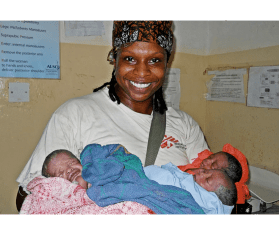Doctors Without Borders/Médecins Sans Frontières (MSF) has seen an increase in cholera patients in some urban areas of Zimbabwe, despite the reported downward trend at the national level.
“The capital Harare, as well as Chitungwiza and Kadoma remain hotspots,” says MSF emergency coordinator Markus Bachmann. “They are again affected by massively deteriorating water supply and particularly poor sanitation.” In order to break the chain of infections, preventive measures are currently being scaled up. This includes increased hygiene education, water distribution, bucket chlorination as well as distribution of hygiene kits in the most affected areas.
Chitungwiza, a city with 350,000 inhabitants about 22 miles south of Harare, is of particular concern. It was the initial focus of the outbreak in August 2008. The Chitungwiza cholera treatment center (CTC) was the first CTC MSF opened in the country on September 2. 2008. “Despite several weeks of low case numbers, now, again, we have seen four consecutive weeks with increasing numbers of patients”, says Bachmann. With 301 patients treated by MSF last week, the number was once again close to the peak reached in early January. The team identified high-risk areas and prepared implementation of water distribution, hygiene promotion and chlorination at the household level. Despite the obvious risk of further escalation, however, authorities have not given permission to implement the proposed preventive measures. The team is currently lobbying on all levels to move forward.
In the high-density suburbs of Harare, patient numbers are increasing or remain at high levels. Water supplies are extremely unstable, which directly translates into more patients. The MSF team in Harare is continuously increasing bucket chlorination and hygiene promotion in hotspot areas. Last week, the team started with the distribution of hygiene kits, including items for transportation, storage, and disinfection of water, as well as soap and educational material to 7,900 households in Glen View suburb.
In Kadoma, 87 miles southwest of Harare, MSF managed to respond to a cluster outbreak which brought the total number of new treated cases to 123 in the past week. This was a 50 percent increase compared to the previous week. A second CTC was added in Kadoma. The team also treated 75 patients in two CTCs in Chegutu district.
Four rapid-response teams are monitoring and responding to outbreaks in the three Mashonaland provinces in northern Zimbabwe. Response activities focus on the districts of Bindura, Shamva, and Mt. Darwin in Mashonaland Central, and Chinhyoi in Mashonaland West, where patient numbers remain high. Besides case management, the teams focus on water and sanitation activities in order to reduce the spread of cholera.



